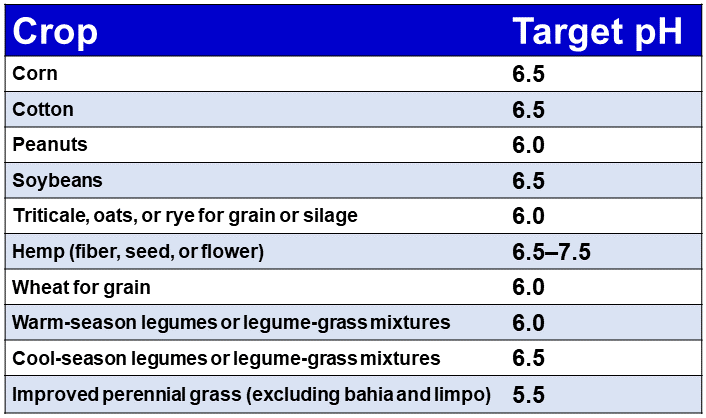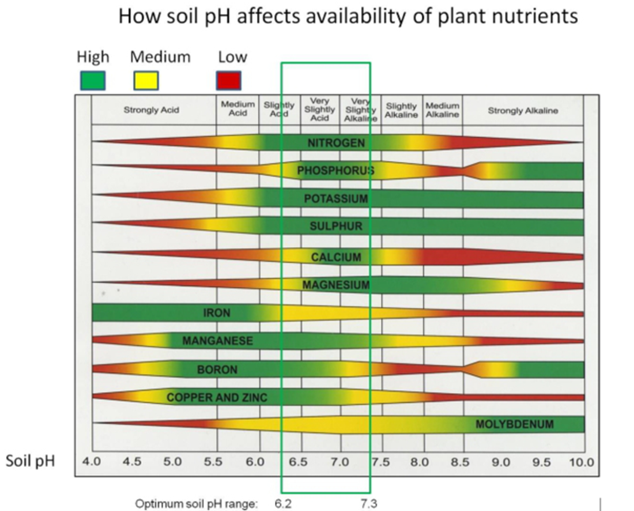Liming, or the application of agricultural lime to soil, is a practice aimed at adjusting soil acidity levels. In North Florida, where acidic soils are common, this becomes an integral part of successful crop management. Many crops and forages perform better at a soil pH above 5.5. The target pH for different row crops is provided in table 1 below. Therefore, liming helps to get the soil pH to the optimum range, improving the availability of the nutrients to the plants and improving crop yield and quality.

Table 1. Target pH for different agronomic crops (Adapted from Mylavarapu et al., 2021)
–
The visual representation of how soil pH affects availability of plant nutrients is shown in Figure 1 below. Fall and early spring are often preferred times for liming, enabling the lime to gradually neutralize acidity before planting season. However, before diving into liming, several essential considerations should be taken into account.
–
Soil testing
The frequency and quantity of liming depends on the soil’s traits and how it’s managed. Factors like nitrogen fertilization and organic material decomposition decrease soil pH. Regular soil testing becomes crucial to monitor pH levels and fertility status accurately. These routine tests offer insights into soil pH and suggest appropriate lime application rates. Repeating soil tests every three years helps catch any emerging fertility issues. Preserving optimal soil pH is a vital component of successful forage and crop fertility programs.
–
Dolomitic vs Calcite lime
The cost and availability of the liming materials are major determining factors when choosing a liming material. Product selection can also depend on a need to supply other nutrients. If calcium fertilization is needed for the peanut fields, it is recommended to use calcite lime, as it serves as source of calcium (Ca). If Magnesium (Mg) is needed, the use of dolomitic lime would be preferred as serves as source of Mg. Make sure you are not over liming while trying to meet Mg requirement, because it is detrimental if over liming increases soil pH beyond 6.3. Also, calcite lime is reported to increase the soil pH quicker as compared to dolomitic lime. There are several other liming by-products which are available, but producers need to know that these by-products are not covered by the law and producers must assume more personal responsibility when using such products. For example: Papermill lime is a product from papermills, which is reported to have effectiveness as liming material. However, it needs to be tested for presence of heavy metals before applying to fields. More information on the effectiveness of different liming materials can be found in the article “Florida: Liming Material Options for Crop, Forage Production”
–
Application time
The timing of lime application is crucial for its effectiveness. While lime can be applied throughout the year, incorporating it during periods when there’s less rainfall allows for better absorption and distribution within the soil. Fall and early spring are often preferred times for liming, enabling the lime to gradually neutralize acidity before planting season begins.
In conclusion, liming is a fundamental practice for maintaining soil health and optimizing crop production in North Florida. By considering factors such as soil testing, lime selection, application timing and techniques, and ongoing monitoring, farmers can make informed decisions that promote sustainable agriculture while maximizing yields.
Remember, each field is unique, and consulting with your local agricultural extension agent or consulting crop agronomists can provide invaluable guidance tailored to specific needs and conditions.
- Potential Winter Cover Crops and Best Management Practices - November 7, 2025
- Managing Peanut Vine Growth with Plant Growth Regulators - May 2, 2025
- Join the 2025 STEP Cotton Competition! - March 28, 2025

